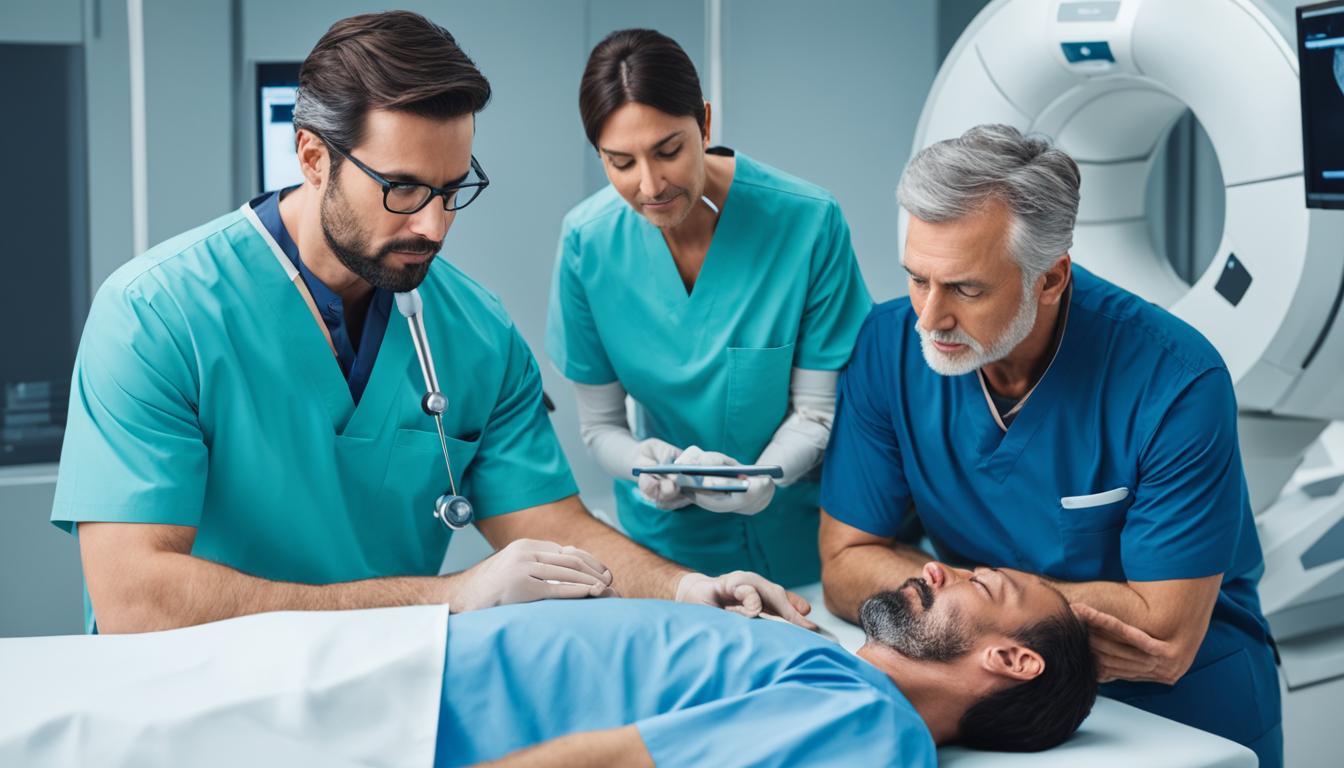Welcome to our comprehensive guide on MRI-guided prostate biopsy. If you are scheduled for this procedure or considering it, you may have questions about what to expect. Here, we will provide you with valuable information about the prostate biopsy procedure, its benefits, and what you can anticipate during and after the biopsy.
Prostate biopsy is a commonly used diagnostic procedure to detect prostate cancer. An MRI-guided prostate biopsy offers increased accuracy in targeting suspicious areas and can provide essential information about the aggressiveness of the cancer. During the procedure, a biopsy gun is used to quickly project a thin needle into the prostate, and small tissue samples are obtained for further analysis.
To help you prepare for the MRI-guided prostate biopsy, we will discuss the necessary steps you should take beforehand, such as providing a urine sample and stopping certain medications. We will also address the potential risks and side effects that may occur, as well as methods for managing any discomfort or pain during the procedure. Additionally, we will explain how the biopsy results are interpreted and the possible next steps based on the findings.
Throughout this guide, we aim to provide you with accurate and reliable information, guiding you through every stage of the MRI-guided prostate biopsy process. Understanding what to expect can help alleviate any anxieties, empower you to make informed decisions, and ensure a successful recovery.
Key Takeaways:
- An MRI-guided prostate biopsy is a procedure that helps diagnose prostate issues, including prostate cancer.
- Preparation for the biopsy involves providing a urine sample, stopping certain medications, and following specific instructions provided by your healthcare team.
- During the procedure, a biopsy gun is used to retrieve small tissue samples from suspicious areas of the prostate for further analysis.
- Potential risks and side effects of the biopsy include bleeding, blood in urine or semen, difficulty urinating, and the rare possibility of infection.
- The biopsy results will be interpreted by a pathologist, who will communicate them to your doctor along with recommendations for further tests or treatment.
Now that you have a brief introduction to MRI-guided prostate biopsy and what to expect, let us delve deeper into the preparation, procedure, and recovery aspects. By the end of this guide, you will have a comprehensive understanding of how an MRI-guided prostate biopsy works and feel more confident about your upcoming or potential procedure.
Preparation for an MRI-Guided Prostate Biopsy
Prior to undergoing an MRI-guided prostate biopsy, certain preparations need to be made to ensure a successful procedure and recovery. These preparations include:
- Providing a urine sample: Your healthcare team may request a urine sample to check for any urinary tract infections that could interfere with the biopsy procedure or recovery.
- Stopping medication: Some medications, such as blood thinners or anti-inflammatory drugs, can increase the risk of bleeding during the biopsy. It’s essential to inform your healthcare provider about any medications you are currently taking, and they will advise you on which ones need to be temporarily stopped.
- Doing a cleansing enema at home: To ensure a clear and unobstructed view of the prostate during the biopsy, your healthcare team may recommend doing a cleansing enema at home. This helps remove any stool or fecal matter from the rectum.
- Antibiotics: Your healthcare provider may prescribe antibiotics to be taken before and after the biopsy procedure to reduce the risk of infection.
It is crucial to follow the post-biopsy instructions provided by your healthcare team to optimize your recovery and minimize any potential complications. These instructions may include:
- Resting and avoiding strenuous activities: You may be advised to take it easy for a day or two following the procedure. Avoiding heavy lifting and strenuous exercise can help prevent bleeding and discomfort.
- Monitoring for signs of infection: Keep an eye for any signs of infection, such as fever, chills, increased pain or swelling at the biopsy site, or difficulty urinating. If you experience any of these symptoms, contact your healthcare provider immediately.
- Taking prescribed medications: If antibiotics or pain medications are prescribed, be sure to take them as instructed by your healthcare provider.
- Drinking plenty of fluids: Staying hydrated by drinking an adequate amount of water can help flush out any residual blood or debris from the biopsy.
- Following up with your healthcare provider: Make sure to schedule a follow-up appointment to discuss the biopsy results, ask any questions, and address any concerns you may have.
Preparing for an MRI-guided prostate biopsy and adhering to the post-biopsy instructions play a vital role in ensuring a smooth and successful procedure. By following these guidelines, you can optimize your chances of obtaining accurate biopsy results and minimize any potential complications.
What to Expect During an MRI-Guided Prostate Biopsy
During the MRI-guided prostate biopsy, you will be asked to lie on your side or stomach. The area will be cleaned, and a thin ultrasound probe will be inserted into the rectum to guide the procedure. The biopsy device will retrieve thin sections of tissue using a spring-propelled needle.
The procedure may cause some discomfort or pain, but pain management techniques will be used to minimize discomfort. It is important to note that there are some risks and potential side effects associated with the biopsy, such as:
- Bleeding
- Blood in urine or semen
- Difficulty urinating
- The rare possibility of infection
These risks and side effects are typically temporary and resolve on their own. Your healthcare team will closely monitor you throughout the procedure and provide necessary support and guidance to manage any discomfort or complications that may arise.
“During the MRI-guided prostate biopsy, the use of an ultrasound probe and a spring-propelled needle allows for the accurate retrieval of tissue samples from the prostate. However, it’s important to be aware of the potential risks and side effects associated with the procedure.”
Prostate Biopsy Results and Interpretation
Once the tissue samples from the prostate biopsy have been obtained, they are sent to a pathologist for analysis. The pathologist will carefully examine the samples, looking for the presence of cancerous cells and determining the aggressiveness of the cancer if it is detected.
During analysis, the pathologist will consider various factors such as the grade and stage of the cancer. The grade indicates how abnormal the cells appear under a microscope, and the stage refers to the extent and spread of the cancer within the prostate gland and beyond.
The pathologist’s findings and interpretations are crucial in understanding your biopsy results. In addition to identifying cancer, the pathologist’s report will provide information on the cancer cells’ behavior, helping your doctor determine the most appropriate treatment options.
After a thorough analysis, your doctor will discuss the results with you. They will explain the findings from the biopsy and help you understand the implications and next steps. The pathologist’s report and your doctor’s expertise will guide any additional tests or treatments required.
It’s important to note that while a prostate biopsy can provide valuable information, it is not always definitive. In some cases, further testing may be necessary to gain a more comprehensive understanding of your condition. Your doctor will provide guidance based on your specific circumstances.
Sample Prostate Biopsy Results Interpretation
| Biopsy Results | Interpretation |
|---|---|
| No cancer cells detected | No evidence of prostate cancer at the sampled locations. |
| Cancer cells detected with low-grade | Prostate cancer is present, but the cells appear less aggressive and may grow slowly. |
| Cancer cells detected with high-grade | Prostate cancer is present, and the cells appear more aggressive and may grow rapidly. |
| Inconclusive results | The biopsy results do not provide a clear understanding of the presence or absence of cancer. Additional testing may be needed. |

Benefits of MRI-Guided Prostate Biopsy
MRI-guided prostate biopsy offers several benefits compared to traditional biopsy methods. It allows for more accurate targeting of suspicious areas in the prostate, reducing the need for multiple biopsy samples. This targeted approach not only improves the diagnostic accuracy but also minimizes the discomfort and potential complications associated with unnecessary biopsies.
One of the key advantages of MRI-guided biopsy is its ability to detect clinically significant prostate cancer. By visualizing the prostate with magnetic resonance imaging (MRI), the procedure can precisely identify areas of concern that may be missed by other biopsy methods. This enables healthcare professionals to detect aggressive forms of prostate cancer at an earlier stage, leading to more effective treatment options and improved outcomes.
The use of multiparametric MRI fusion-guided biopsy further enhances the diagnostic capabilities of MRI-guided prostate biopsy. This advanced technique combines multiple imaging parameters and fuses them with real-time ultrasound images to create a comprehensive view of the prostate. By integrating different imaging modalities, multiparametric MRI fusion-guided biopsy increases the accuracy of cancer detection and reduces the number of unnecessary needle cores taken during the biopsy procedure.
With the help of MRI-guided prostate biopsy, healthcare providers can obtain a more comprehensive understanding of the nature and aggressiveness of the detected cancer. This valuable information plays a crucial role in developing personalized treatment plans tailored to the individual patient’s needs. By ensuring that the appropriate treatment is administered, MRI-guided biopsy helps optimize patient outcomes and improves the overall management of prostate cancer.

Possible Complications and Side Effects
While MRI-guided prostate biopsy is generally considered safe, there are possible complications and side effects associated with the procedure. It is important to understand these risks and discuss them with your healthcare provider before undergoing the biopsy.
Bleeding at the Biopsy Site
One possible complication of MRI-guided prostate biopsy is bleeding at the biopsy site. This is a common side effect and usually resolves on its own within a few days. However, if you experience excessive bleeding or prolonged bleeding, it is important to contact your healthcare provider for further evaluation.
Blood in Urine or Semen
Another potential side effect of the biopsy is the presence of blood in urine or semen. This is also a common occurrence and typically resolves within a week or two. If you notice persistent or significant blood in your urine or semen, it is recommended to consult with your healthcare provider for proper assessment.
Difficulty Urinating
Some individuals may experience temporary difficulty urinating after an MRI-guided prostate biopsy. This can be due to swelling or inflammation in the prostate or surrounding tissues. If you have trouble urinating or experience discomfort while urinating, it is important to seek medical advice to ensure appropriate management.
Rare Possibility of Infection
While rare, there is a small risk of infection associated with MRI-guided prostate biopsy. The procedure involves inserting a needle into the prostate, which can introduce bacteria. If you develop symptoms such as fever, increased pain, or persistent urinary symptoms, it is crucial to seek prompt medical attention as these may be signs of infection.
“Although complications and side effects can occur, it is important to remember that MRI-guided prostate biopsy is a valuable diagnostic tool for detecting prostate cancer and other prostate conditions. The risks associated with the procedure are generally low, and the benefits of accurate diagnosis far outweigh the potential complications.”
Summary of Possible Complications and Side Effects:
| Possible Complications and Side Effects |
|---|
| Bleeding at the biopsy site |
| Blood in urine or semen |
| Difficulty urinating |
| Rare possibility of infection |
Recovery After an MRI-Guided Prostate Biopsy
After undergoing an MRI-guided prostate biopsy, it is common to experience some discomfort and minor bleeding from the rectum. You may also notice blood in your urine or semen, which can persist for several days or even weeks. Remember, these symptoms are normal and part of the recovery process.
During this time, it is crucial to take it easy and avoid strenuous activities. Your healthcare provider may recommend light activities for a day or two to allow your body to heal properly. Make sure to follow their post-biopsy instructions carefully to minimize any complications.
In addition, your doctor may prescribe antibiotics to prevent any potential infections. It is important to complete the full course of antibiotics as instructed to reduce the risk of complications.
If you experience any unusual symptoms or have concerns during your recovery, do not hesitate to reach out to your healthcare provider. They are there to support you throughout the process and address any questions or worries you may have.
| Recovery Tips After an MRI-Guided Prostate Biopsy |
|---|
| 1. Take it Easy: Engage in light activities and avoid strenuous exercise for a day or two. |
| 2. Monitor Symptoms: Keep an eye on any unusual symptoms or concerns and report them to your healthcare provider. |
| 3. Antibiotics: Complete the full course of antibiotics prescribed by your doctor to prevent infections. |
| 4. Stay Hydrated: Drink plenty of fluids to flush out any residual blood and promote healing. |
| 5. Follow Instructions: Adhere to the post-biopsy instructions provided by your healthcare team for optimal recovery. |
Conclusion
Based on its diagnostic capabilities and accuracy in targeting suspicious areas, MRI-guided prostate biopsy is a valuable procedure for diagnosing prostate issues, especially prostate cancer. Despite potential risks and side effects, the benefits outweigh the complications, making it an effective tool for healthcare professionals. To ensure a smooth and successful recovery, it is crucial to understand what to expect during and after the procedure and follow the provided post-biopsy instructions.
If you are scheduled for an MRI-guided prostate biopsy, it is important to consult with your healthcare provider for specific post-biopsy instructions. These instructions typically include guidelines for managing any discomfort or pain, as well as recommendations for activities and medication. By adhering to these instructions, you can enhance your recovery process and minimize any potential complications.
Remember, if you have any concerns or questions before or after the procedure, do not hesitate to reach out to your healthcare provider. They are there to support you and address any uncertainties you may have. The journey to a proper diagnosis and treatment plan starts with a well-executed MRI-guided prostate biopsy, so stay informed, follow instructions, and prioritize your health.
FAQ
What can I expect during an MRI-guided prostate biopsy?
During an MRI-guided prostate biopsy, a thin needle will be used to remove small sections of tissue from the prostate for analysis. You may experience some discomfort or pain, but pain management techniques will be used to minimize this. It is important to follow the post-biopsy instructions provided by your healthcare team.
How should I prepare for an MRI-guided prostate biopsy?
Prior to the procedure, you may need to provide a urine sample to check for urinary tract infections. It is also important to stop taking any medication that can increase the risk of bleeding, and to do a cleansing enema at home. Antibiotics may be prescribed to prevent infection post-biopsy. Follow the pre-biopsy instructions provided by your healthcare provider.
What are the potential risks and side effects of an MRI-guided prostate biopsy?
While the procedure is generally safe, there are possible complications and side effects, such as bleeding at the biopsy site, blood in urine or semen, difficulty urinating, and the rare possibility of infection. It is important to discuss these risks with your healthcare provider before undergoing the procedure.
How are the results of a prostate biopsy interpreted?
The tissue samples obtained during the prostate biopsy will be sent to a pathologist for analysis. The pathologist will assess the samples for the presence of cancerous cells and determine the aggressiveness of the cancer if detected. Your doctor will communicate the results to you, along with any recommendations for further tests or treatment.
What are the benefits of MRI-guided prostate biopsy?
MRI-guided prostate biopsy offers greater accuracy in targeting suspicious areas of the prostate, reducing the need for multiple biopsy samples. It helps in detecting clinically significant prostate cancer and provides information about the aggressiveness of the cancer. This technique has been shown to improve cancer detection rates and reduce unnecessary needle cores.
What are the possible complications and side effects of an MRI-guided prostate biopsy?
Possible complications and side effects of an MRI-guided prostate biopsy include bleeding at the biopsy site, blood in urine or semen, difficulty urinating, and the rare possibility of infection. Discuss these potential risks with your healthcare provider before undergoing the procedure.
How long does it take to recover after an MRI-guided prostate biopsy?
After the biopsy, it is normal to experience some soreness and light bleeding from the rectum. There may also be blood in the urine or semen, which can last for a few days or weeks. Your doctor may recommend light activities for a day or two and prescribe antibiotics to prevent infection. Follow your doctor’s post-biopsy instructions and report any unusual symptoms or concerns during your recovery.
What post-biopsy instructions should I follow?
It is important to follow the post-biopsy instructions provided by your healthcare team. These may include taking prescribed antibiotics, avoiding strenuous activities for a specific period, and reporting any unusual symptoms or concerns. Your doctor will provide specific instructions tailored to your individual case.
Should I Expect Any Driving Restrictions After Undergoing an MRI-Guided Prostate Biopsy?
After undergoing an MRI-guided prostate biopsy, it’s important to follow safety tips for driving. Your doctor may advise you to avoid driving for a certain period of time due to potential discomfort or medication effects. Always consult with your healthcare provider for specific recommendations regarding driving restrictions.



